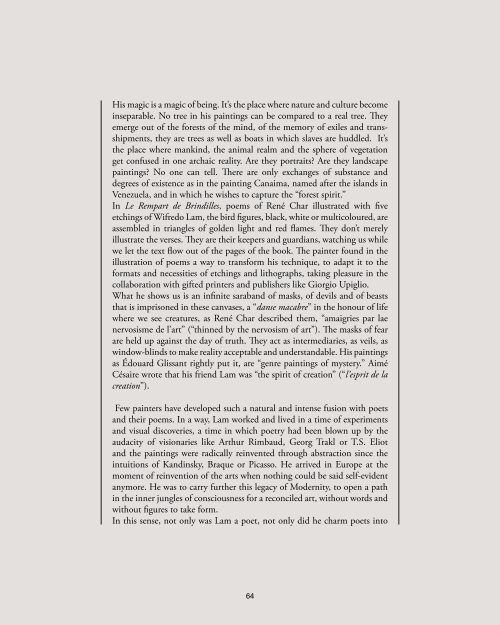Dominique de Villepin – The fraternity of sorcerers: Wifredo Lam and the poets
Excerpt from the book “Wifredo Lam – Nouveau Nouveau Monde”, a fully illustrated catalogue published in English on the occasion of the eponymous special exhibition.
Excerpt from the book “Wifredo Lam – Nouveau Nouveau Monde”, a fully illustrated catalogue published in English on the occasion of the eponymous special exhibition.
Create successful ePaper yourself
Turn your PDF publications into a flip-book with our unique Google optimized e-Paper software.
His magic is a magic <strong>of</strong> being. It’s <strong>the</strong> place where nature <strong>and</strong> culture become<br />
inseparable. No tree in his paintings can be compared to a real tree. They<br />
emerge out <strong>of</strong> <strong>the</strong> forests <strong>of</strong> <strong>the</strong> mind, <strong>of</strong> <strong>the</strong> memory <strong>of</strong> exiles <strong>and</strong> transshipments,<br />
<strong>the</strong>y are trees as well as boats in which slaves are huddled. It’s<br />
<strong>the</strong> place where mankind, <strong>the</strong> animal realm <strong>and</strong> <strong>the</strong> sphere <strong>of</strong> vegetation<br />
get confused in one archaic reality. Are <strong>the</strong>y portraits? Are <strong>the</strong>y l<strong>and</strong>scape<br />
paintings? No one can tell. There are only exchanges <strong>of</strong> substance <strong>and</strong><br />
<strong>de</strong>grees <strong>of</strong> existence as in <strong>the</strong> painting Canaima, named after <strong>the</strong> isl<strong>and</strong>s in<br />
Venezuela, <strong>and</strong> in which he wishes to capture <strong>the</strong> “forest spirit.”<br />
In Le Rempart <strong>de</strong> Brindilles, poems <strong>of</strong> René Char illustrated with five<br />
etchings <strong>of</strong> <strong>Wifredo</strong> <strong>Lam</strong>, <strong>the</strong> bird figures, black, white or multicoloured, are<br />
assembled in triangles <strong>of</strong> gol<strong>de</strong>n light <strong>and</strong> red flames. They don’t merely<br />
illustrate <strong>the</strong> verses. They are <strong>the</strong>ir keepers <strong>and</strong> guardians, watching us while<br />
we let <strong>the</strong> text flow out <strong>of</strong> <strong>the</strong> pages <strong>of</strong> <strong>the</strong> book. The painter found in <strong>the</strong><br />
illustration <strong>of</strong> poems a way to transform his technique, to adapt it to <strong>the</strong><br />
formats <strong>and</strong> necessities <strong>of</strong> etchings <strong>and</strong> lithographs, taking pleasure in <strong>the</strong><br />
collaboration with gifted printers <strong>and</strong> publishers like Giorgio Upiglio.<br />
What he shows us is an infinite sarab<strong>and</strong> <strong>of</strong> masks, <strong>of</strong> <strong>de</strong>vils <strong>and</strong> <strong>of</strong> beasts<br />
that is imprisoned in <strong>the</strong>se canvases, a “danse macabre” in <strong>the</strong> honour <strong>of</strong> life<br />
where we see creatures, as René Char <strong>de</strong>scribed <strong>the</strong>m, “amaigries par lae<br />
nervosisme <strong>de</strong> l’art” (“thinned by <strong>the</strong> nervosism <strong>of</strong> art”). The masks <strong>of</strong> fear<br />
are held up against <strong>the</strong> day <strong>of</strong> truth. They act as intermediaries, as veils, as<br />
window-blinds to make reality acceptable <strong>and</strong> un<strong>de</strong>rst<strong>and</strong>able. His paintings<br />
as Édouard Glissant rightly put it, are “genre paintings <strong>of</strong> mystery.” Aimé<br />
Césaire wrote that his friend <strong>Lam</strong> was “<strong>the</strong> spirit <strong>of</strong> creation” (“l’esprit <strong>de</strong> la<br />
creation”).<br />
Few painters have <strong>de</strong>veloped such a natural <strong>and</strong> intense fusion with <strong>poets</strong><br />
<strong>and</strong> <strong>the</strong>ir poems. In a way, <strong>Lam</strong> worked <strong>and</strong> lived in a time <strong>of</strong> experiments<br />
<strong>and</strong> visual discoveries, a time in which poetry had been blown up by <strong>the</strong><br />
audacity <strong>of</strong> visionaries like Arthur Rimbaud, Georg Trakl or T.S. Eliot<br />
<strong>and</strong> <strong>the</strong> paintings were radically reinvented through abstraction since <strong>the</strong><br />
intuitions <strong>of</strong> K<strong>and</strong>insky, Braque or Picasso. He arrived in Europe at <strong>the</strong><br />
moment <strong>of</strong> reinvention <strong>of</strong> <strong>the</strong> arts when nothing could be said self-evi<strong>de</strong>nt<br />
anymore. He was to carry fur<strong>the</strong>r this legacy <strong>of</strong> Mo<strong>de</strong>rnity, to open a path<br />
in <strong>the</strong> inner jungles <strong>of</strong> consciousness for a reconciled art, without words <strong>and</strong><br />
without figures to take form.<br />
In this sense, not only was <strong>Lam</strong> a poet, not only did he charm <strong>poets</strong> into<br />
64

















